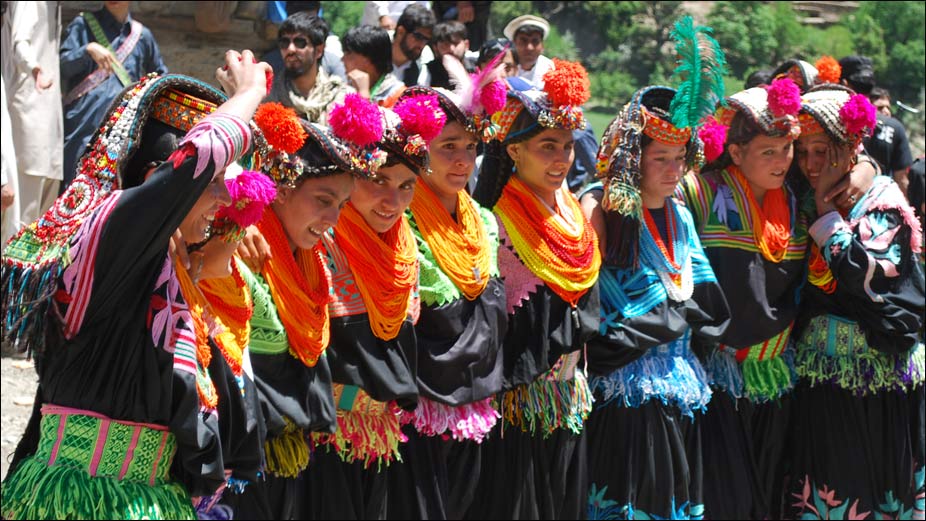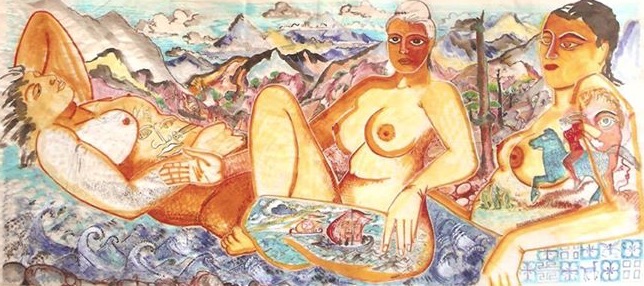Kalash Literature
"Brargini, doy tazim"
History of the Kalash
"I dedicate this page to my good friend, M. Bugi, his family, and to the
Kalash people ('mountain people'), located
in a beautiful valley
high up in the Himalaya Mountains."
Kalash
Literature
- Urdu
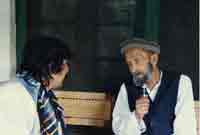
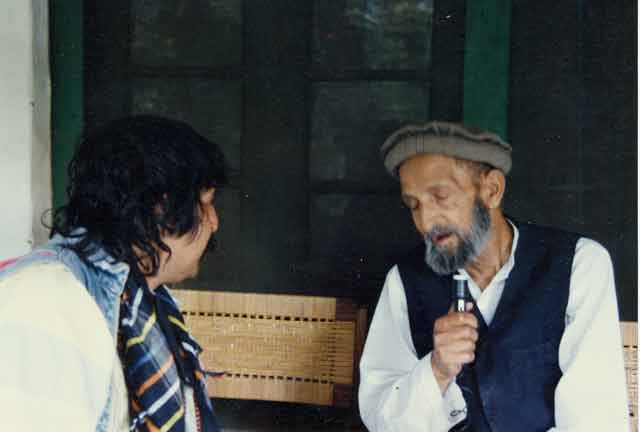
Only Chitrali scholar invited
to Cultural conference of
the Hindukush,
1973


Lakshan
Bibi Kalash meets PM Gilani 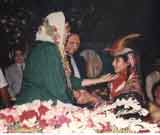
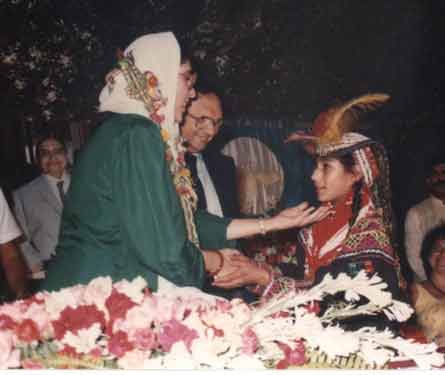
Benazir
Bhutto with Kalash 1989
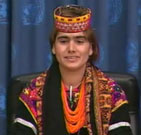
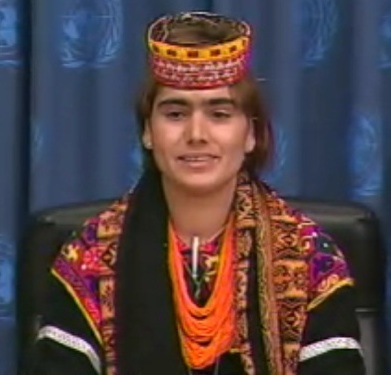
Lakshan Bibi
speaking at the UN
Kalash Blog
Lakshan
Bibi speaking at the
UN regarding global
warming
May 22, 2007
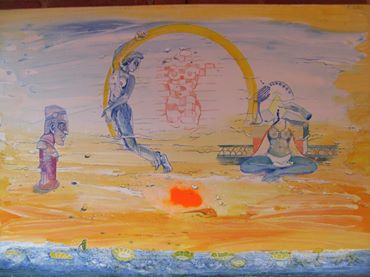
- Chitral and Kalash Valley
- Eyes to See, Eyes to Heal
- Honoring Geronimo
- Horse Holiday
- Hunza Photo Gallery
- Noor Khan Photo Gallery
- Images of China
- Into the breach
- Kafiristan
- Kalash Kafirs of Chitral
- Kalasha Peoples Call for Cultural Survival
- Living Personification
My Poem for
the Kalash People
- The forgotten Kalash - Pakistan
- Faces of the
Kalash
- Oh the Blessed Kalash
- Poems for Lee Shou Ping
- Samina Khayal Baig
- Two-week
Kalash festival kicks off
- Hindukush
- Kalash Art Show
- Kalash
Blog
- Kalash
Brochure
- Kalash
- Dictionary
- Kalash Education
- Kalash
Heritage
- Kalash
Language
- Kalash
Citizens
- Kalash
People
- Kalash Poetry
- Kalash
Products
- Kalash
Traditions
- Kalash Valley
- Kalasha
Dictionary - Urdu
- Kalasha Times
- Kalash: Wikipedia
- Pakistan Journal
- Photo Gallery
- Search Our Site
- Who are the Kalash?
- You Tube Videos
- Year of the Kalash: 1989
- The Kalasha and the Crescent
- Homage to Bashara Khan Kalash
- The Kalash in Quarantine
Mahraka.com
A Website on the Culture,
History and Languages of Chitral.
- Chitral vs Outer Hebrides
Click on Buttons above to access links
The
Kalash or Kalasha,
are an ethnic group found in the Hindu Kush mountain
range in the Chitral district of the North-West
Frontier Province of Pakistan. Although quite numerous before the
twentieth century, this non-Muslim group has been partially assimilated
by the larger Muslim majority of Pakistan and seen its
numbers dwindle over the past century. Today, sheikhs, or converts to
Islam, make up more than half of the total Kalasha-speaking population.
The culture of Kalash
people is unique and differs drastically from the various ethnic
groups surrounding them. They are polytheists and nature plays a highly
significant and spiritual role in their daily life. As part of their
religious tradition, sacrifices are offered and festivals held to give
thanks for the abundant resources of their three valleys. Kalash
mythology and folklore has been compared to that of ancient Greece, but
they are much closer to Indo-Iranian (Vedic and pre-Zoroastrian)
traditions.
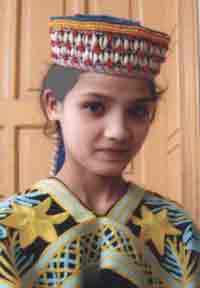
The Chitralis are still speaking today one of the oldest Indo-European languages in a relatively undiluted form. This is not surprising in view of the remoteness of their area. They are so far up in the Hindu Kush mountains that it would be almost impossible for an invader to conquer them. By far the lowest pass into Chitral is Lowari Top, which is over 10,000 feet high, too high for an invading army easily to cross. The path up the Kunar river from Jalalabad becomes so narrow below Ashret that no invading army has ever tried it. There have been several attempts to invade Chitral within relatively modern historical times. One group came across Boroghol Pass, were defeated and went back. Another group came across Urtsun Pass. The British in 1895 simultaneously came across Shandur Pass and Lowari Top in a mission to rescue a group British hostages which had been taken. They conquered the area, which is the reason why Chitral is now part of Pakistan.
The world's highest polo playground is located here. It is surrounded by some of the most spectacular mountains in the world. The history of this annual polo tournament at the Shandur Top dates back to 1936 when a British Political Agent, Major Cobb organised the first polo tournament here. Major Cobb was fond of playing polo under full moon and he developed a polo ground near Shandur that was named after him and is still known as 'Major Cobb Moony Polo Ground'. Polo fans gather at Shandur from all over the world to participate in the spectacular polo events during this tournament.
Mainland Pakistan refers to the people of Punjab, Sindh and Peshawar.
The Kalash people and their way of life are being destroyed by tourism like this.Modern progress should never be used at the expense of any peoples culture.
Wonderful To Pay Tributes to HISTORY, and there is No shame in admitting that Great Artists have Influenced me, Instead of Finding Easy routes for fame Fortune and Glory I LOVE my Teachers, as i call Myself a Student of History,lots of My works are There, to support one of Its Kind, he is a Master, Jamil Naqsh Was My Teacher in Pakistan, as well as Father of Danish Azar Zuby I learnt a Lot from Them,,as well as Multiple images Of Surrealism, Hieronymus Bosch the GREAT Master, and Of Course what u see here Is REMBRANDT-
Words Of Johanna from USA, half Greek Half American-(QUOTE). For several years now, i have been privileged to be a part of a movement in acknowledgment of Kalash and indigenous tribes by our dear one, MBugi....the incorporation of Mr. Wajid's choice of music enhances the beautiful/loving paintings MBugi presents to us; his love for people around the world is more than inspiring, it is uplifting! He encourages w/out his knowing....touches heart strings so deeply that one is lead to follow such a person so dedicated. MBugi's ability to coordinate and make possible to all the works of his lifetime. Most assuredly, he has and will leave such a legacy. I as well, include the children; who are our future. The children who come to us to learn with desire and he makes it possible for them to exhibit their feelings/emotions in to art in the finest ways. All who observe, come in to contact w/him are included in his tributes to his people of Pakistan. It IS humbling when after so many years he continues
INNOVATIONS OF REMBRANDT
Rembrandt Harmenszoon Van Rijn, who many consider the greatest artist of all time, learned all that was then known about oil painting while still a very young man, surpassing his teachers very early in his career, and then proceeded to add his own discoveries to the technical knowledge of his time. To this day Rembrandt’s best works remain unsurpassed, and serve as inspiration to those of us who paint. This being the case, any book on advanced techniques must address Rembrandt separately and at such length as the author's knowledge allows. What technical information Rembrandt was taught may be discerned by studying the works of his instructors, Jacob Isaacxszoon Van Swanenburch and Pieter Lastmann. Such study also immediately shows the genius of Rembrandt by the extent to which he so obviously surpassed them both, and by how early in his career he did so. Nonetheless, his training under them was an important factor in his artistic development,
Nonetheless, his training under them was an important factor in his artistic development, and should not be minimized, as both teachers seem to have possessed a working knowledge of the painting methods in use at that time. Various examples of Rembrandt’s work show that he was not limited to any one technique, but employed them all, the choice depending on which approach best suited the subject in question, and for what purpose the painting was intended. His facility with all three of the aforementioned methods of painting soon led him to combine aspects of one with another, and to add innovations of his own.
*Sitarist is Nikhil Banerjee Raag Darbari *--- and I hope that you Will Write some thing please, as After the Petition is Finished i shall Continue for Promotion of Arts In Pakistan,__/\__
Vir Kashmiri ........quote,.......infatuating the lingering music in the background is gripping.....its still running.....
Vir Kashmiri ........Bugi ji you are sheer joy thank you greatly for your presence...
MBugi- it took me 40 Long Years to Compile Work as well as Collect These Images, and Syed Wajid Based in Dubai Chose and Gave structure to My Ideas, as Great Master and His association with Mughals was Attributed, Most Of the Western Press Hides his Copies for it Brings Prejudice against Him,, Copying Masters,I also Got a Cold Shoulder from Rembrandt Museum In Amsterdam---I carried On Regardless, RESULT is Here, Specially The last Letter from National College Of Arts Now we will Try to work On *FAIZ AMAN MELA*
Please contact M. Bugi at:to do all we can to prevent this cultural loss.
The Kalash people will be forever grateful for all of your support!
Burushaski Song and Images of my adopted Kalash families,
from MBugi Bugi Bugiandassociates.
Thank you. I hope that you will remember The Silk-Route is full of Poets, Stories and Songs:
Travelled from heart to heart before the actual writing were written,
I am very proud of the area, although I am not from there.
This is one of the best films I have seen about the Kalash and the people of the area of Chitral, Nager, Hunza.
In this small region more then 10 ancient Languages are spoken and the anthropologists are puzzled.
Mr George Morgersterine from Norway wrote in 1935 that the area has no parallel to other areas in the whole world,
with such richness in culture and so strong in history.
 Return to
Indigenous Peoples' Literature
Return to
Indigenous Peoples' Literature
Compiled by: Glenn Welker
